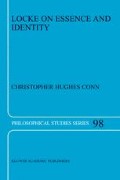Abstract
In the previous chapter I argued that the organisms and persons in Locke’s ontology have both spatial and temporal extent, and hence both spatial and temporal parts. While I do not claim that Locke was fully aware of these four-dimensional implications, I suspect that he was aware of them at some level of his understanding. It is important to point out, however, that not much rides on this supposition. For on my interpretation, the organisms and persons in Locke’s ontology have both spatial and temporal extent whether he is aware of this or not. Hence he is a four-dimensionalist, whether he is aware of this or not.
Access this chapter
Tax calculation will be finalised at checkout
Purchases are for personal use only
Preview
Unable to display preview. Download preview PDF.
Notes
For a summary of Cartwright’s argument, see Paulo Dau (1986,471f).
Heller points out that three-dimensionalists respond to this contradiction in various ways. Thus, for example, van Inwagen (1981) avoids this contradiction by accepting (b), Chisholm (1973) avoids it by accepting (c), Judith Jarvis Thomson (1983) avoids it by accepting (d), and Geach (1967) avoids it by accepting (e).
According to Chisholm (1979) and Shoemaker (1979), Thomas Reid and Bishop Butler also maintain this view of organisms. But unlike Hume, they do not think that persons are entia successiva. For Reid’s views on these matters, see the third and sixth essays of his Essays on the Intellectual Powers of Man (found in Perry (1975)). For Butler’s, see his “Of Personal Identity,” which is the first appendix of his Analogy of Religion (1736), and which is also found in Perry (1975).
See, for example, Roderick Chisholm (1971, 11-13) and (1976, 138-40); and Mark Heller (1990, 21-23).
Richard Taylor (1955, 601) points out that this statement fails to identity a simple and obvious difference between space and time. For just as an object can be in a single place at more than one time if it lasts long enough, an object can be in more than one place at a single time if it is large enough.
Quoted from and translated by Bennett and Remnant (1978, 3). For the untranslated version of this letter, and for Lady Masham’s response, see C. I. Gerhardt’s edition of Leibniz’s correspondence, Die Philosophischen Schriften von Gottfried Wilhelm Leibniz (Berlin, 1875-90), vol. 3, pp. 297f, and 364.
Quoted from and translated by Bennett and Remnant (1978, 5). For other discussions of Coste’s encounter with Newton, see A. C. Fraser’s critical edition of the Essay (1894, 321-22n); Alexendre Koyré (1965, 91-93); Howard Stein (1970, 274-75); Martin Tamny (1979); Roger Woolhouse (1982); Thomas Lennon (1984); and Michael Ayers (1991, 2:59, 304n.85).
This fragment of Newton’s (henceforth cited as De Gravitatione) was first published (in Latin and English) and translated by Rupert Hall and Marie Hall (1962). For discussions of the date of this work, see Hall and Hall (1962, 89), Howard Stein (1970, 274n.11), and Roger Woolhouse (1982, 88n.10).
Here I follow Arnold Koslow (1976, 242).
For a detailed account of the various possible dates of their acquaintance, see G. A. J. Rogers (1978, 230f).
Martin Tamny has argued that these successively existing bodies cannot be spatio-temporally continuous with one another For, he writes, “no matter how quickly God managed these successive endowments and withdrawals [of impenetrability], they would still remain successive and thus denumerable, which means that these bodies would not have spatio-temporal continuity” (1979, 56). Tamny is mistaken. The denumerability of these successive manifestations of impenetrability has nothing to do with their spatio-temporal continuity, since it is clearly possible for successively existing objects to be spatiotemporally continuous with one another. For arguments to this effect, see Sydney Shoemaker (1979), and David Armstrong (1980).
Author information
Authors and Affiliations
Rights and permissions
Copyright information
© 2003 Springer Science+Business Media Dordrecht
About this chapter
Cite this chapter
Conn, C.H. (2003). Objections and Replies. In: Locke on Essence and Identity. Philosophical Studies Series, vol 98. Springer, Dordrecht. https://doi.org/10.1007/978-94-007-1005-4_5
Download citation
DOI: https://doi.org/10.1007/978-94-007-1005-4_5
Publisher Name: Springer, Dordrecht
Print ISBN: 978-94-010-3765-5
Online ISBN: 978-94-007-1005-4
eBook Packages: Springer Book Archive

